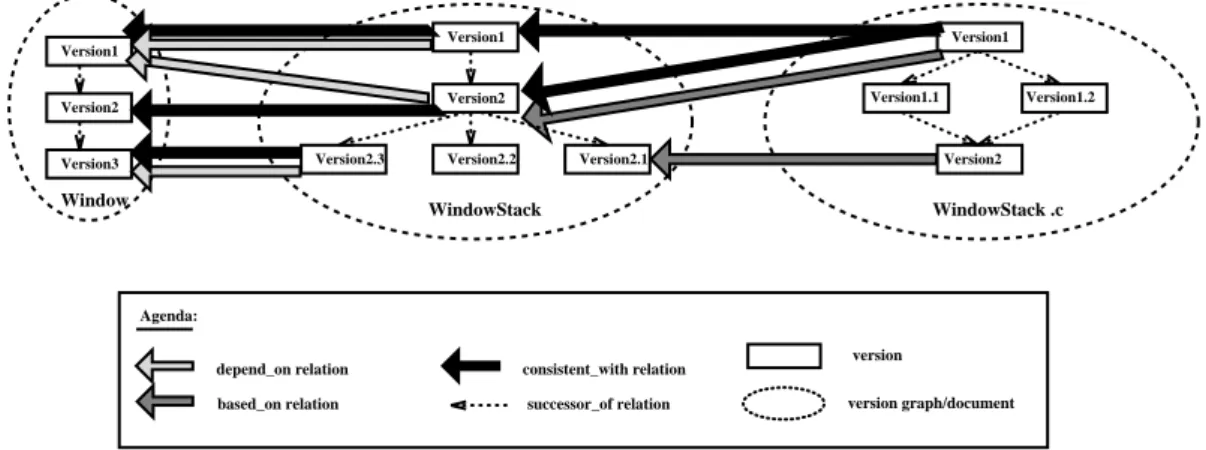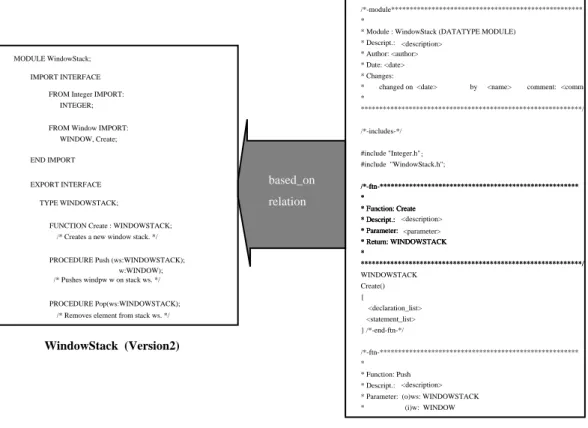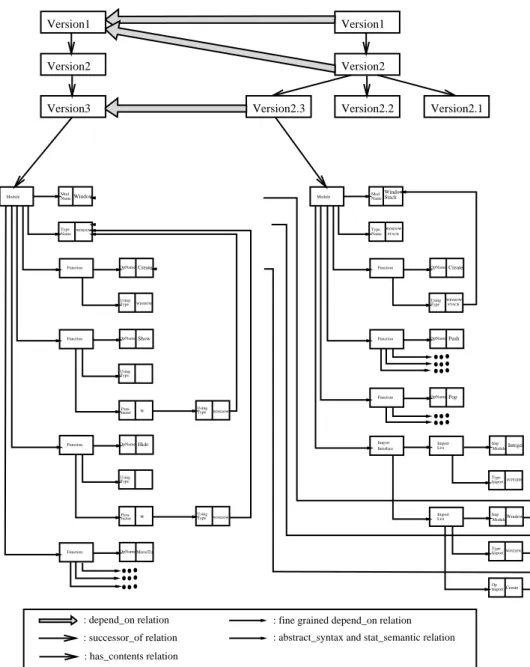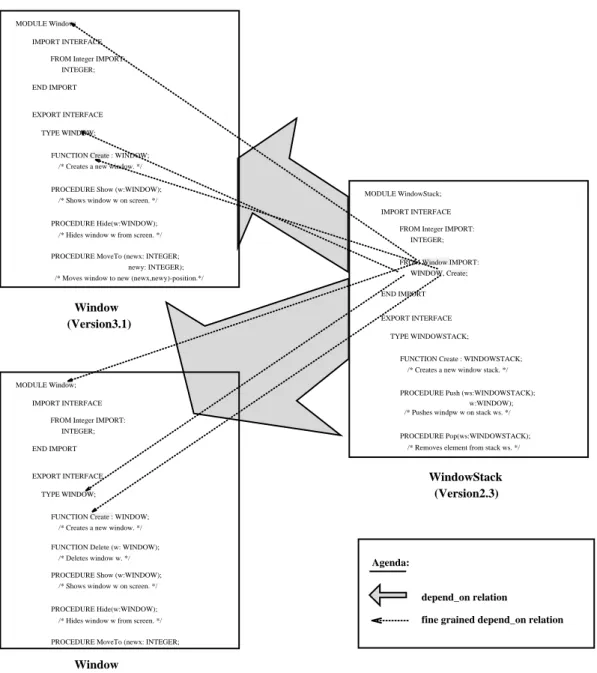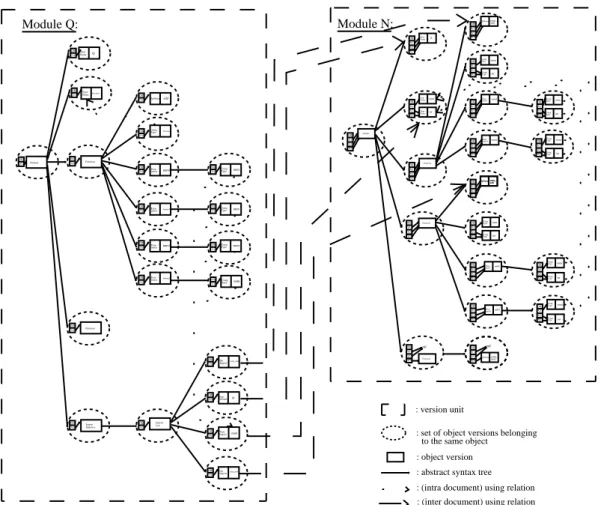Environments
Sabine Sachwehand WilhelmSchafer
Universitat GH Paderb orn
Fachb ereich17 - Mathematik/Informatik
D-33095 Paderb orn
Germany
sachweh@uni-paderb orn.de
wilhelm@uni-pad erb orn .de
Abstract
Thepap erintro ducesaversionmanagementmo delwhichexploitsknowledgeab outthecontents
ofdo cuments. Thisisincontrasttomostexistingmo delswhichbasicallyconsiderversionedobjects
asat (attributed)les. Theb enets ofthe approachare illustrated by describing somesample
op erationswhicharenotp ossible withaconventional mo del. Thepap erthendiscussesafeasible
implementationofthemo delontopofan existingobject-orienteddatabasemanagementsystem.
Finally, it discusses related work and indicates how a sophisticated conguration management
systemisb eing builtontopoftheversionmanagementsystem.
1 Introduction
Theenormousincreaseinthesizeofsoftwareandthereliabilityrequiredfrommo dernsoftwareintensive
systems hasfo cussed attention onlanguages andcorresp onding to ols which donotonlysupp ort pro-
grammingbutalsosp ecication,design,anddo cumentationofsoftware. Infact,sp ecicationordesign
do cumentshave b ecomeequallyimp ortantas the nalco de inorderto check and verifycorrectness,
completeness andreliabilityofadelivered softwarepro duct. Inaddition,theindustrial-scale pro duc-
tion ofsoftwareto day requiresteamsofdevelop ers whoshould b e supp ortedbyto ols whichorganise
access to alargeamountofshared and frequently changinginformation. This informationconsists of
the ab ove mentioneddo cumentsforthevariousphases of thesoftwarepro duction pro cess. Examples
for such do cuments are data-ow diagrams, state-transition diagrams, p etri-nets, entity-relationship
diagrams,andmo dulardesigndescriptions.
To ols supp ort the syntactically and static semantically correct construction of do cuments which is
denoted as intra-document consistency. Atightlyintegrated softwareengineeringenvironment(SEE)
isacollectionofto olssupp ortingvariousphasesofthepro ductionpro cess. Itsmainadditionalfeature
compared with a to ol which supp orts the construction of a single do cument in a single language,
is the p ossibility to maintain so-called inter-document dependency and consistency. An example for
inter-do cument consistency is a name of a function which should b e the same in the requirements
sp ecication,intheinterfacedenitionofamo duleinthedesigndo cumentandintheimplementation.
The advantage of an SEE which maintainssuch ne-grained dep endencies b etween do cuments is its
supp ortofanincremental,intertwinedpro ductionandmaintenancepro cess (incontrasttoawaterfall-
or phase-oriented approach). Consider as an example the situation that a programmer may have
detectedanerrorintheco dewhichisduetoawrongrequirementssp ecicationofaparticularfunction.
If then the sp ecication is changed, the environmentcould informthe user ab out allother places in
all other do cuments which are aected by this change. It could even propagate achange trough all
do cumentsconcernedautomatically,iftheuser(s)requireit. Incontrast,doingsuchasmallincremental
onacomplete transformationofalldo cumentsconcerned fromone phase intothenextone. Formore
details we referto [ELN +
92].
Furthermore,anSEE shouldsupp ort changecontroland multipleusers. Thisrequiresasophisticated
versionandcongurationmanagementsystem(VM/CM).Although,SEEswhichmaintainne-grained
dep endenciesasmentionedab ove,arenowexisting[Lew88],mostavailableVM/CMmo delsstillassume
a very coarse-grained object mo del. Basically, versioned objects corresp ond to les whose particular
contents is not considered e.g. [Tic82, Fel88, BE87, ML88]. Such a coarse-grained version mo del
makesitimp ossibletopreserve inter-do cumentdep endencies andtocontrolchangepropagationonthe
ne-grained levelsketched ab ove. Illustratingexampleswillfollowinthenextsection.
Themainnewfeaturespresentedinthispap erare:
theconcept of aversion mo delwhich is tuned tone-grained inter-do cumentdep endencies and
corresp ondingchangecontrol
afeasibleapproachhowsuchaconceptisimplementedontopofanexistingcommerciallyavailable
fullyobject-orienteddatabase system.
The reminder of this pap er is organised as follows: The next section describ es and formalises our
underlying version mo del whereas section 3 gives an overview on the version op erations which are
availabletoauser. Thissectiontriestoclarifywhataretheb enetsofourmo del. Section4describ es
howsuchamo delisimplementedontopofanobject-orienteddatabasemanagementsystemandthus
providesevidencethattheapproachisfeasible. Section5dealswithrelatedworkandsection6sketches
ongoingwork.
2 The VM Model
TheVMMo delisdenedbyasystemversiongraph,whichisatwolevelgraphstructurewhichconsists
of the version level and the increment level. The objects (no des) on theversion level corresp ond to
do cumentversions,whereas theno desontheincrementlevelcorresp ondtothesyntactic constructsof
ado cumentversion,i.e. do cumentversions arerepresentedinternallybyabstractsyntax graphs. The
relations(edges)ontheversionlevelarerenedontheincrementlevelanalogouslytotheno des. Con-
sequently,theincrementlevelrepresentstherenementoftheversionlevel. Note,thatthegranularity
ofversioningisado cument,consequentlythetermversionisusedassynonymforadocument version
inthe following. Furthermore, theincrement levelis needed to preserve theconsistency of do cument
versions,whereas theversionlevelisusedas baseforcongurationmanagement.
2.1 Version Level
Theversionlevelcontainsadocumentversiongraphforeachdo cumentofthesystem,whichrepresents
the developmenthistory of this do cument. A do cumentversion graph consists ofno des which repre-
sentthedierentversions(andtheirrenementsas explainedinthefollowingsection)andasuccessor
relationwhich denes thedevelopmenthistory. A do cument version graph is singlero oted, since the
developmentofeach do cumentstartswithaninitialversionfromwhichallotherversionsofthisdo cu-
mentarederived,anditisacyclic,b ecause itrepresentsthedevelopmentstepsduring thepro duction
ofado cument.
Inter-do cument dep endencies, as sketched in the previous section, are expressed by further relations
whichconnect versions indierent do cumentversion graphs. We callthesource versionof arelation
depending versionandthetarget versiondetermining versionresp ectively. Basically,aversion can b e
adepending version andadetermining versionat the sametime. Forexample, adesignversionmay
do cumentdep endencies are distinguished,whicharethebasedon relationandthedepend onrelation,
as isillustratedingure1.
Agenda:
WindowStack .c Window
WindowStack
consistent_with relation Version1
successor_of relation Version1
depend_on relation version
based_on relation version graph/document
Version2
Version3
Version1
Version1.2 Version1.1
Version2 Version2
Version2.1 Version2.2
Version2.3
Figure 1: Anexample forthe versionlevelofa system version graph
Adepend onrelationdescrib es inter-do cumentdep endencies whicharedenedbyreferencingaversion
based on the contents of a version of another do cument. As an example assume that Window and
WindowStackareexcerptsfromasystemdesignwhichisgivenintermsofmo dulesanduse-relationships
b etweenmo duleswhicharedenedbyaMIL(Mo duleInterconnection Language). Inadditionassume
that the two mo dules have b een designed rather indep endently p ossibly by two dierent designer
(groups). WindowStackdep endsonWindowb ecauseitimp ortsresourcesdenedintheexp ortinterface
of window. Thus asystemdesignerhasto indicate explicitlywhichversion oftheWindowshould b e
used, as shown in gure 2. (Note that the exp ort interface of dierent versions of Window could
actually b e dierent.) Note that gure 2do es not showan extract of asystem version graph, but it
w:WINDOW);
Window (Version3) WindowStack (Version2.3)
PROCEDURE Pop(ws:WINDOWSTACK);
/* Removes element from stack ws. */
EXPORT INTERFACE
FUNCTION Create : WINDOWSTACK;
/* Creates a new window. */ TYPE WINDOWSTACK;
newy: INTEGER);
/* Moves window to new (newx,newy)-position.*/
FUNCTION Create : WINDOW;
PROCEDURE MoveTo (newx: INTEGER;
/* Shows window w on screen. */
PROCEDURE Hide(w:WINDOW);
/* Creates a new window stack. */
PROCEDURE Show (w:WINDOW);
TYPE WINDOW;
/* Hides window w from screen. */
Version1 Version2 Version3 Module Window Select Version of
/* Pushes windpw w on stack ws. */
EXPORT INTERFACE
PROCEDURE Push (ws:WINDOWSTACK);
MODULE WindowStack;
IMPORT INTERFACE
END IMPORT WINDOW, Create;
INTEGER;
MODULE Window;
IMPORT INTERFACE
END IMPORT INTEGER;
FROM Integer IMPORT: FROM Integer IMPORT:
FROM Window
depend_on relation
Figure2: Anexample for explicitreferencingunderversion control
gives an examplehowdependon relations of a systemversion graph can b e established ina textual
representation,i.e. howtheusersees them.
A basedon relation describ es that a text frame of the depending version was generated or up dated
based onthecorresp onding determiningversion,likeforexamplethegenerationofco de-framesbased
onadesign do cument. Changingthedep ending version meansto llinthegeneratedframe,i.e. the
generatedframeofthedepending versioncannotb echanged. Considerforexamplegure3thatshows
do cumentnamed WindowStack (Version2). For each imp ort-clausein the designversion an include
statementwasgeneratedandforeachexp ortedop eration,theinterfaceofthecorresp ondingc-function
wasgenerated. ThismeansalmostallincrementsofWindowStack.c(Version1)showninthisgureare
generatedexcept ofthoseenclosedinbrackets(<...>),i.e. onlythelatterincrementscanb eexpanded
inordertollintheframe. Theconsistencyb etweentheseversionsisensuredbypropagatingchanges
fromthedeterminingversiontothedependingversion. Again,analogouslytogure2gure3do esnot
w:WINDOW);
WindowStack (Version2)
WindowStack.c (Version1)
* Descript.:
* Parameter:
* Return: WINDOWSTACK
************************************************************/
*
*
* Function: Create
/*-ftn-******************************************************
* Parameter:
* Return: WINDOWSTACK
* Descript.:
************************************************************/
/*-ftn-******************************************************
*
* Function: Create
* Descript.:
* Return: WINDOWSTACK
*
*
************************************************************/
/*-module****************************************************
*
*
* Descript.:
* Author: <author>
* Date: <date>
* Changes:
* changed on by comment:
*
************************************************************/
* Parameter:
#include "Integer.h" ;
#include "WindowStack.h";
WINDOWSTACK
* Function: Create
* Module : WindowStack (DATATYPE MODULE)
<declaration_list>
<statement_list>
} /*-end-ftn-*/
/*-ftn-******************************************************
*
* Descript.:
* Function: Push
* Parameter: (o)ws: WINDOWSTACK
* (i)w: WINDOW PROCEDURE Push (ws:WINDOWSTACK);
/* Pushes windpw w on stack ws. */
/*-includes-*/
/* Creates a new window stack. */
PROCEDURE Pop(ws:WINDOWSTACK);
/* Removes element from stack ws. */
FUNCTION Create : WINDOWSTACK;
EXPORT INTERFACE TYPE WINDOWSTACK;
FROM Integer IMPORT:
INTEGER;
FROM Window IMPORT:
WINDOW, Create;
IMPORT INTERFACE
END IMPORT MODULE WindowStack;
{ Create()
based_on relation
<description>
<date> <name> <comm
<description>
<parameter>
<description>
/*-ftn-******************************************************
Figure 3: Anexample fora generationdep endency
showanexcerpt ofasystemversiongraph,but auser's viewontwoparticularversions.
A nal relation which is established on the version level is the consistent with relation. It describ es
that twoversionsareconsistent witheachother. Thisrelationwillformthebasisforacorresp onding
congurationmanagementmo del,i.e. congurationsareusuallybuiltbasedonconsistentversions.
Twoversionsv
1
(determiningversion)andv
2
(dep endingversion)areconsistentconcerningabasedon
or dependon relation, if for each incrementi
2 of v
2
that is determined by anincrement i
1 of v
1 the
followingequationholds: i
2
=i
1
. (Insteadoftakingtheidentityfunction(aschosen inthispap er) any
otherfunctionf canb eused, i.e. moregeneraltheequationtob e heldis: i
2
=f(i
1 ).)
Thebasedon relationandthedepend onrelationonlydescrib e dep endencies b etween versionsbut do
notdene whether or nottwoversions areconsistent. Rememb ertheexampleshown gure 2. Ifthe
exp orted typ e WINDOW inversion 3 ofdo cumentWindow is changed to SCROLLBAR-WINDOW,
version 2.3 of do cument WindowStack is still dep ending on this version of Window, b ecause of its
imp ort-clause. Butb othversionsarenotconsistentanylonger,since thetyp eWINDOWhasnotb een
changed intheimp ortpartofversionWindowStack sofar.
We havedistinguished dierent typ es of inter-do cumentdep endencies andcorresp onding relationson
theversionlevelbasedonhowthesourceandtargetversionsofthosedep endencies haveb eencreated.
Theedgesontheversionlevelhoweverdonotprovidetheinformationonthelevelofversioncontents,
e.g. thedepend onrelationandp ossiblytheconsistentwithrelationb etweenWindowStackandWindow
donotdescrib ethatthisdep endencyisinparticular,duetotheimp ortoftyp eWINDOWandfunction
Create.Therefore,itisnotp ossibletoidentifyonlybytheinformationwhichisprovidedbytheversion
level,that achange ofpro cedure Show or Hideresp ectively (e.g. extendingtheparameterlist)would
notviolatetheconsistency b etweenWindowand WindowStack.
Inordertoprovidethis missinginformation,versionno des,depend onrelationsandbasedonrelations
arerened ontheincrementlevel. A version isrepresented byitsabstract syntax graph(ASG). This
is expressed bya has contents relationb etween ano de onthe version leveland the ro otno de of the
abstractsyntaxgraphofitscorresp ondingversion. Similarlytono desthedependon,basedonandthe
successorof relationare renedonthe incrementlevel. Thoserelations startat no desof theASG of
the source version and end at corresp onding no des of theASG of the target version. Corresp onding
no desmeansthero otno desofthesyntacticconstructs(intheASG-representations)whichcorresp ond
to theconstructs intheversionsconcerned which have b eeneither identied explicitlybytheuser in
the case of a dependon relation (e.g. typ e WINDOW and pro cedure Create inFig. 2) or which are
dened by themappingb etween thelanguageof thedetermining and thelanguageofthe dep ending
versioninthecaseof abasedon relation(e.g. theIMPORTINTERFACEand theinclude commands
inFig. 3). Figure4showstheunderlyinggraph structure oftheexamplegiveningure 2. Note,that
thesuccessor of relationisrenedanalogously.
The onlyrelationoftheversionlevel,that is notrenedontheincrementlevelis theconsistent with
relation. Theconsistency concerning anexistinginter-do cumentdep endencyis checkedautomatically
bythe environmentusingthe ne-grainedbasedon or depend on relations, i.e. itis derivedfromthe
informationavailablethrough thelattertworelationsand thedenitionof aconsistentstate b etween
twoversions.
2.3 Formalisation of the Graph Model
Sofar,wehavedescrib ed informallyourversionmo delwhichbasicallycorresp ondstoatwo-levelgraph
structure. Thisgraph structure isnowformalisedwhich enablesto formallydene theconsistent, i.e.
practicallyreasonablestatesofaversiongraph.Thosedenitionsarethebasisfortheimplementationof
theVM-op erationswhichareexplainedinthenextsection,i.e. theycanb econsideredasthedenitions
oftheop erations'invariants(similarlyto thedenitionofinvariantsinalanguagelikeEIFFEL).
Asystemversiongraphconsistsoftwodisjointno desubsets, namelyVERandINC,whichrepresent
theno desoftheversionlevelandincrementlevelresp ectively. Analogously,thesetofedgesconsistsof
threedisjointsetsofedges,namelyVERREL,INC RELandVERINC REL,whereasVERREL
denotesamulti-setsincethedependonrelationaswellasthebasedonrelationmayb edenedb etween
thesameno desas theconsistentwith relation.
VERREL inturn consists ofsets which represent thedependon, basedon, successor of andconsis-
tent with relationoftheversionlevelandanalogouslyINC RELconsists ofsets which represent the
abstractsyntax, statsemantic, ne grained depend on, ne grained based on and ne grained succes-
sor ofrelationoftheincrementlevel:
VERREL=D EPEND O N[BASED O N[SUCCESSO R O F[
CO NSISTENT WITH.
VERVER
Version1
Version2
Version3
Version1
Version2
Version2.3 Version2.2 Version2.1
Module Name
ModWindow Stack
Name TypeWINDOW
STACK
Function
Function OpNameCreate
Using Type
WINDOW STACK
Import Interface
Import List Import
List Module
Imp Integer
Type ImportINTEGER
Module Imp Window
Type ImportWINDOW
Import Op Create
Module Name
ModWindow
Name Type WINDOW
Function
Using Type WINDOW OpNameCreate
Function OpNameShow
Using Type
meter
Para- Using
w Type WINDOW
Function
Function OpName MoveTo
Using
Function OpNameHide
Type
meter
Para- Using
w Type WINDOW
: fine grained depend_on relation : abstract_syntax and stat_semantic relation : successor_of relation
: has_contents relation
OpNamePush
OpNamePop
: depend_on relation
Figure4: Anexample fora systemversiongraph
INC REL= ABSTRACT SYNTAX [STAT SEMANTIC[REF D EPEND O N[
REF BASED O N[REF SUCCESSO R O F
. INCINC.
TheVERINC REL setcontainsalledgesofthetyp ehas contents, whichareedgesconnectingb oth
levels:
VERINC REL=HAS CO NTENTSVERINC
Firstorderlogicisusedtoformallydescrib ewhichrestrictionsholdforthecombinationofthoseedges,
i.e. theab ovementionedconsistentstatesofaversiongrapharedened. Wedonotgiveallrestrictions
here butrathersketchafewexamplestoillustrate thebasic idea.
In order to preserve the consistency of asystem, the environmentshould provide consistency preser-
vation ondemand. Thus, temp oraryinconsistencies areallowed,but theuser maycallafunctionfor
change propagation to make a depending version consistent with adetermining version. Inorder to
than one outgoing depend on or basedon relation to versions of the same do cument version graph.
ThismeansifO
v s
isdened asthesetofoutgoingdependonandbasedon edgesofaversionv
s ,
8v
s
2VER:O
v s
=f(v
s
;v
t )jv
t
2VER ^((v
s
;v
t
)2D EPEND O N_(v
s
;v
t
)2BASED O N)g
thefollowingconsistency conditionhastob e fullledbyeachversiongraph:
8(v
s
;v
t )2O
v s ::9v
t
0 2VER:(v
s
;v
t 0)2O
v s
^
(((v
t
;v
t
0)2(SUCCESSO R O F)
_(v
t 0;v
t
)2(SUCCESSO R O F)
)_
(9v
p
2VER:(v
p
;v
t
)2(SUCCESSO R O F)
^
(v
p
;v
t 0)
2(SUCCESSO R O F)
)))
Note, that(SUCCESSO R O F)
denotesthetransitiveclosureofSUCCESSO R O F.
The ab ove consistency conditionwillb e illustratedbythe followingexample. Assume that aversion
w:WINDOW);
(Version3.1)
(Version2.3)
(Version3.2) Window
WindowStack Window
Agenda:
IMPORT INTERFACE
END IMPORT
/* Creates a new window. */
PROCEDURE MoveTo (newx: INTEGER;
newy: INTEGER);
INTEGER;
/* Moves window to new (newx,newy)-position.*/
PROCEDURE Show (w:WINDOW);
/* Shows window w on screen. */
PROCEDURE Hide(w:WINDOW);
/* Hides window w from screen. */
EXPORT INTERFACE
FUNCTION Create : WINDOW;
MODULE Window;
TYPE WINDOW;
INTEGER;
IMPORT INTERFACE
END IMPORT
/* Creates a new window. */
FUNCTION Create : WINDOW;
WINDOW, Create;
/* Deletes window w. */
PROCEDURE MoveTo (newx: INTEGER;
PROCEDURE Show (w:WINDOW);
/* Shows window w on screen. */
PROCEDURE Hide(w:WINDOW);
FROM Integer IMPORT:
MODULE Window;
EXPORT INTERFACE TYPE WINDOW;
/* Hides window w from screen. */
depend_on relation
fine grained depend_on relation
FROM Window IMPORT:
INTEGER;
FROM Integer IMPORT:
TYPE WINDOWSTACK;
EXPORT INTERFACE
FUNCTION Create : WINDOWSTACK;
/* Removes element from stack ws. */
PROCEDURE Pop(ws:WINDOWSTACK);
/* Creates a new window stack. */
/* Pushes windpw w on stack ws. */
FUNCTION Delete (w: WINDOW);
FROM Integer IMPORT:
MODULE WindowStack;
END IMPORT IMPORT INTERFACE
PROCEDURE Push (ws:WINDOWSTACK);
Figure 5: Fine-grainedinter-do cumentdep endencies
ofdo cumentWindowStackandtwoversionsofdo cumentWindowaregiven,wherebytheversions(3.1
and 3.2) of the latter do cument are variants.(Variants are versions which are memb ers of dierent
